Knots
Introduction
|
Knots weaken all ropes because they distort the fibres.
When knotted rope is strained to its braking point, it almost always fails
at the knot or close to it, unless it is damaged elsewhere.
The bending, crushing and chafing forces that hold a knot in place also
unevenly stress rope fibres and ultimately lead to a reduction in strength.
A simple overhand knot, for example, reduces the strength of polyester or
polyamid line by as much as 65 percent.
That same knot can reduce a high-modulus line's strength even more,
leaving little or no safety margin.
Loop splices can maintain nearly the complete rope's strength.
Nevertheless, in most situations forming loops and bends with conventional knots is far more practical.
But this is only save if a large enough safety margin in the strength of rope is chosen to compensate
for the weakening effects not only of knots but also of ageing, wearing, damage, shock loading, etc.
Therefore, the working load limit of a rope is generally specified with a significant safety factor,
of up to 15:1 for critical applications. |
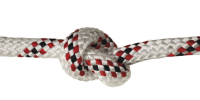
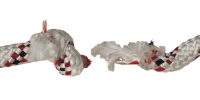
|
Classification
Knots may be roughly divided into the following categories:
- loops: make a loop in a rope or more generally, join two ends of the same line
- bends: join one rope to another rope to obtain a longer rope
- hitches: attach a rope to a fixed object (mostly round such as a pole, boom, spar, .. )
Knot Strength
Relative knot strength, also called knot efficiency, is the breaking strength of a knotted rope
in proportion to the breaking strength of the rope without the knot.
Determining a precise value for a particular knot is difficult because many factors can affect
a knot efficiency test: the type of fiber, the style of rope, the size of rope,
whether it is wet or dry, how the knot is dressed before loading, how rapidly it is loaded,
whether the knot is repeatedly loaded, and so on.
The efficiency of common knots ranges between 40-80% of the rope's original strength.
The following table gives an indication of the knot efficiency for a selection of knots and
rope combinations:
| Knot efficiency | 3-Strand Polyester | Braided Polyester | HD Polyethylene |
| Eye Splice | 95% | 80% | 80% |
| Anchor Bend | 65% | 70% | 35% |
| Bowline | 60% | 45% | 35% |
| Double Fisherman's Knot | -- | 55% | 30% |
| Reever Knot | -- | -- | -- |
| Zeppelin Bend | -- | -- | -- |
| Double Sheet Bend | -- | 45% | 20% |
| Clove Hitch | -- | -- | -- |
As mentioned, these numbers are just an indication of what can be expected as remaining strength
from the original, unknotted rope strength.
Knot Security
Even if the rope does not break, a knot may still fail to hold.
Knots that hold firm under a variety of adverse conditions are said to be more secure than those that do not.
Repeated, dynamic loads will cause virtually every knot to fail.
The main reasons why knots fail to hold are:
Slipping: The load creates tension that pulls the rope back through the knot
in the direction of the load. If this continues far enough, the working end passes into the knot and the knot
unravels and fails. This behaviour can worsen when the knot is repeatedly strained and let slack, dragged over
rough terrain, or repeatedly struck against hard objects such as a masts and flagpoles.
Even with secure knots, slippage may occur when the knot is first put under real tension.
This can be mitigated by leaving plenty of rope at the working end outside of the knot, and by dressing
the knot cleanly and tightening it as much as possible before loading. Sometimes, the use of a stopper knot or,
even better, a backup knot can prevent the working end from passing through the knot; but if a knot is observed
to slip, it is generally preferable to use a more secure knot. Life-critical applications often require backup
knots to maximize safety. Capsizing: To capsize (or spill) a knot is to
change its form and rearrange its parts, usually by pulling on specific ends in certain ways.
When used inappropriately, some knots tend to capsize easily or even spontaneously.
Often the capsized form of the knot offers little resistance to slipping or unraveling.
A reef knot, when misused as a bend, can capsize dangerously.
Sometimes a knot is intentionally capsized as a method of tying another knot, as with the
"lightning method" of tying a bowline. Some knots, such as the Carrick bend, are generally
tied in one form then capsized to obtain a stronger or more stable form. Sliding: In knots that are meant to grip other objects, failure can be
defined as the knot moving relative to the gripped object. While the knot itself does not fail,
it ceases to perform the desired function. For instance, a simple rolling hitch tied around a railing
and pulled parallel to the railing might hold up to a certain tension, then start sliding.
Sometimes this problem can be corrected by working-up the knot tighter before subjecting it to load,
but usually the problem requires either a knot with more wraps or a rope of different diameter or material. Releasability: Knots differ in the effort required to untie them after loading.
Knots that are very difficult to untie, such as the water knot, are said to "jam" or be jamming knots.
Knots that come untied with less difficulty, such as the Zeppelin bend, are referred to as "non-jamming".
Some Useful Knots
Loops
Eye Splice: The eye splice is a method of creating a
permanent loop (an "eye") in the end of a rope by means of rope splicing.
There are several techniques of creating the eye with its knot tied back to the line.
Spliced eyes are preferred to knotted loops. While a knot typically reduces the
strength by 20–40%, a splice is capable of almost attaining a rope's full strength.
Most types of splices are used on standard 3-stranded rope, but some can be done
on 12-strand or greater single-braided rope, as well as most double braided lines.
While a spliced 3-strand ropes' strands are interwoven to create the splice, a braided rope's
splice is constructed by pulling the rope back into its jacket at the joint of the loop.
To achieve a reliable loop with an eye splice, some special experience is required. -
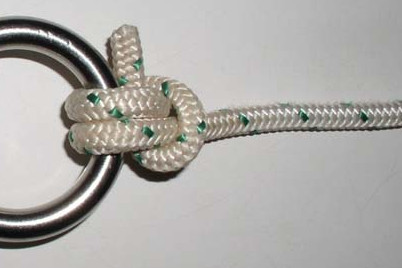
Anchor Bend: The anchor bend is useful for fastening
lines to anchor rings or other fixed objects suited for mooring (bars, bollards, hoops, ...).
This bend is more secure than the similar round turn and two half-hitches, but
it cannot be tied or untied under load.
While the knot can become jammed in some modern rope materials, it is usually
easily untied after moderate loads.
The anchor bend can be made more resistant to jamming by taking an extra turn
around the object (finishing half-hitch).
Bowline:
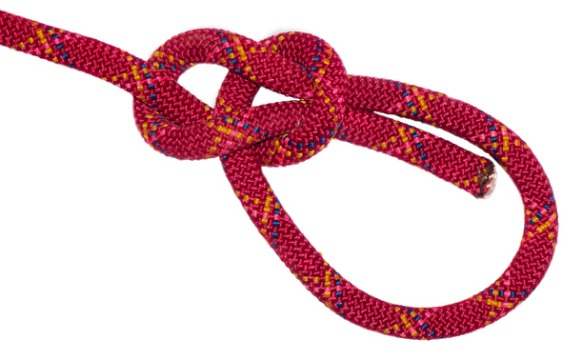 The bowline is an ancient and simple knot
used to form a fixed loop at the end of a rope.
It has the virtues of being both easy to tie and untie after having been loaded.
Although generally considered a reliable knot, its main deficiencies are a tendency
to work loose when not under load, to slip when pulled sideways and the bight portion
of the knot to capsize in certain circumstances.
To address these shortcomings, a number of more secure variations of the bowline have
been developed.
The bowline is an ancient and simple knot
used to form a fixed loop at the end of a rope.
It has the virtues of being both easy to tie and untie after having been loaded.
Although generally considered a reliable knot, its main deficiencies are a tendency
to work loose when not under load, to slip when pulled sideways and the bight portion
of the knot to capsize in certain circumstances.
To address these shortcomings, a number of more secure variations of the bowline have
been developed.
A standard three-stranded polyester rope - often used for mooring - with a bowline
retains approximately 60% of its strength. A braided polyester rope with a bowline
- often used for sheets - may retain around 50% of its strength.
Note however, that knot efficiency shows considerable variances depending upon on a
variety of factors. -
Reef Knot: The reef knot, or square knot, is an ancient
and simple binding knot used to secure a rope or line around an object.
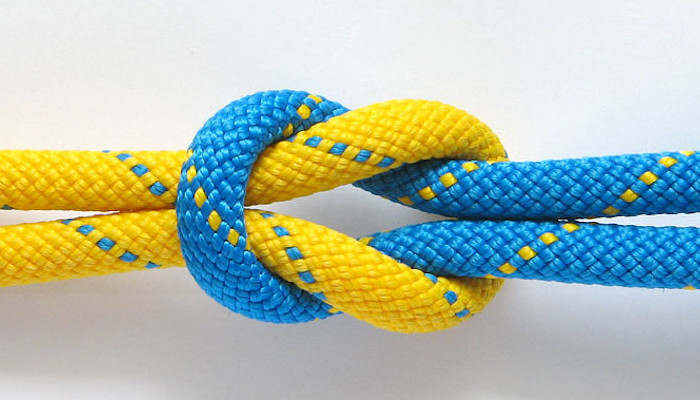 The reef knot is found on some 4000-years old egyptian statues as belt knot.
The knot is formed by tying a left-handed overhand knot and then a right-handed
overhand knot on top of the first one, or vice versa.
The free ends of the reef knot must end up both at the same side and parallel to their
corresponding standing parts, otherwise a thief knot results, which easily slips under load.
The name "reef knot" originates from its common use to reef sails, that is to tie part
of the sail down on the boom.
To release the knot a sailor could collapse it by pulling one of the free ends outward.
The sail's weight would make the collapsed knot come apart.
It is specifically this behaviour which makes the knot unsafe for connecting two ropes together.
The reef knot is found on some 4000-years old egyptian statues as belt knot.
The knot is formed by tying a left-handed overhand knot and then a right-handed
overhand knot on top of the first one, or vice versa.
The free ends of the reef knot must end up both at the same side and parallel to their
corresponding standing parts, otherwise a thief knot results, which easily slips under load.
The name "reef knot" originates from its common use to reef sails, that is to tie part
of the sail down on the boom.
To release the knot a sailor could collapse it by pulling one of the free ends outward.
The sail's weight would make the collapsed knot come apart.
It is specifically this behaviour which makes the knot unsafe for connecting two ropes together.
Bends
Splice: Splicing is a technique of connecting two stranded lines of the
same diameter by interweaving strands of rope rather than the whole lines as is done with knots.
This is more time-consuming and semi-permanent, but usually much stronger than simple knots. Sheet Bend: The sheet bend (also known as weaver's knot) is a bend,
used to join two ropes together. The double sheet bend, is often used for binding lines of different
diameter together, although it has a tendency to work loose when not under load.
Practically only the double sheet bend, which has lower tendency to slip or loosen should be used.
The extra turn with the thinner line adds more friction, making the bend more secure.
Notice that, in order to have any strength, the two free ends should appear on the same side of the knot.
Otherwise, the sheet bend will slip and release completely, even under moderate load.
Reever Knot: The Reever Knot is a secure and non-jamming bend for joining two ropes.
An important attribute of the knot is that each line going in and out of the knot is clamped at
two points within the knot. For this reason it is considered secure and resistant to being shaken
loose when subject to intermittent loads.
For better handling and better knot security, the tails may be fixed to the standing parts
with some whipping twine.
Double Fisherman's Knot:
The double fisherman's knot or grapevine knot is a bend used to join two lengths of rope.
The knot is formed by tying a double overhand knot, with each end around the opposite line's standing part
(in its strangle knot form; the drop form is often used in mountaineering).
This knot and the triple fisherman's knot (recommended for high-lubricity high-tech rope) show a
knot efficiency of about 60%.
In a number of practical tests, these knots proved to be the best bends, preserving more than half of the maximum
rope strength. For better capstan or winch handling and also for better knot security,
the tails may be seized to the standing parts.
Drawback of this bend is it's poor releasability after heavy loading.
Carrick Bend:
The carrick bend is a knot, particularly appropriate for joining very heavy rope or
cable that is too large and stiff to easily be formed into other common bends.
It will not jam even after carrying significant load or being soaked with water.
In order to prevent collapsing of the knot, the tails must be seized to the standing parts.
Without seizings, the carrick bend will not preserve it's initial shape under load.
Zeppelin Bend:
A Zeppelin bend (also Rosendahl bend) is a general-purpose bend knot.
It is a secure, easily tied, and jam-resistant way to connect two ropes.
Though its simplicity and security may be matched by other bends, it is unique in the
ease with which it can be untied, even after heavy loading.
Drawback is that the free ends of the lines are not parallel to
the loaded parts, making it harder to pull this knot through a ring or pulley.
Hitches
Clove Hitch (Double Hitch):
A clove hitch is two successive half-hitches around an object.
It is most effectively used as a crossing knot.
This knot is particularly useful where the length of the running end needs to be adjustable,
since feeding in rope from either direction will loosen the knot to be tightened at a new position.
With certain types of cord, the clove hitch can slip when loaded.
It is also unreliable when used on a square or rectangular post, rather than round.
With smaller diameter cords, after being heavily weighted it may become difficult to untie.
Others
Monkey's fist: The monkey's fist knot is most often used as the weight
at the end of a heaving line, making it easier to throw.
The knot is usually tied around a small weight, such as a stone, marble, or a piece of wood. Sailmaker's Whipping:
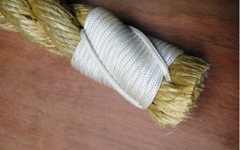 Used to secure twisted lines from unraveling. The twine is first threaded diagonally through the rope.
The twine is then wrapped round the rope including the diagonally threaded end.
A needle is then used to thread the two ends through the rope to enclose the wrapping turns.
Finally a reef (square) or a string of reef (square) knots is tied.
Then this string of reef (square) knots is pulled through the rope to bury the ends.
Used to secure twisted lines from unraveling. The twine is first threaded diagonally through the rope.
The twine is then wrapped round the rope including the diagonally threaded end.
A needle is then used to thread the two ends through the rope to enclose the wrapping turns.
Finally a reef (square) or a string of reef (square) knots is tied.
Then this string of reef (square) knots is pulled through the rope to bury the ends.
Sources
|



 The bowline is an ancient and simple knot
used to form a fixed loop at the end of a rope.
It has the virtues of being both easy to tie and untie after having been loaded.
Although generally considered a reliable knot, its main deficiencies are a tendency
to work loose when not under load, to slip when pulled sideways and the bight portion
of the knot to capsize in certain circumstances.
To address these shortcomings, a number of more secure variations of the bowline have
been developed.
The bowline is an ancient and simple knot
used to form a fixed loop at the end of a rope.
It has the virtues of being both easy to tie and untie after having been loaded.
Although generally considered a reliable knot, its main deficiencies are a tendency
to work loose when not under load, to slip when pulled sideways and the bight portion
of the knot to capsize in certain circumstances.
To address these shortcomings, a number of more secure variations of the bowline have
been developed. The reef knot is found on some 4000-years old egyptian statues as belt knot.
The knot is formed by tying a left-handed overhand knot and then a right-handed
overhand knot on top of the first one, or vice versa.
The free ends of the reef knot must end up both at the same side and parallel to their
corresponding standing parts, otherwise a thief knot results, which easily slips under load.
The name "reef knot" originates from its common use to reef sails, that is to tie part
of the sail down on the boom.
To release the knot a sailor could collapse it by pulling one of the free ends outward.
The sail's weight would make the collapsed knot come apart.
It is specifically this behaviour which makes the knot unsafe for connecting two ropes together.
The reef knot is found on some 4000-years old egyptian statues as belt knot.
The knot is formed by tying a left-handed overhand knot and then a right-handed
overhand knot on top of the first one, or vice versa.
The free ends of the reef knot must end up both at the same side and parallel to their
corresponding standing parts, otherwise a thief knot results, which easily slips under load.
The name "reef knot" originates from its common use to reef sails, that is to tie part
of the sail down on the boom.
To release the knot a sailor could collapse it by pulling one of the free ends outward.
The sail's weight would make the collapsed knot come apart.
It is specifically this behaviour which makes the knot unsafe for connecting two ropes together.
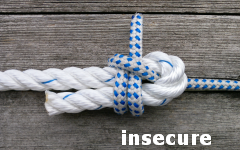
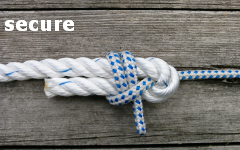
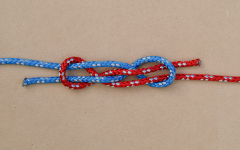
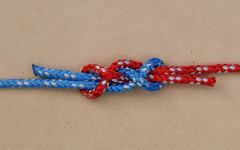
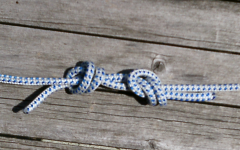
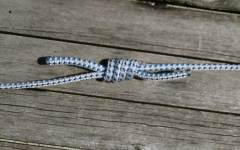
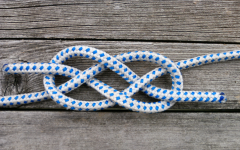
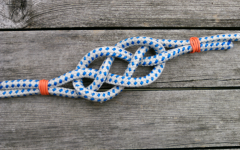
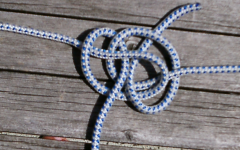
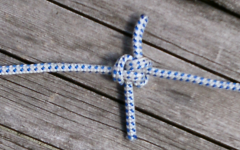
 Used to secure twisted lines from unraveling. The twine is first threaded diagonally through the rope.
The twine is then wrapped round the rope including the diagonally threaded end.
A needle is then used to thread the two ends through the rope to enclose the wrapping turns.
Finally a reef (square) or a string of reef (square) knots is tied.
Then this string of reef (square) knots is pulled through the rope to bury the ends.
Used to secure twisted lines from unraveling. The twine is first threaded diagonally through the rope.
The twine is then wrapped round the rope including the diagonally threaded end.
A needle is then used to thread the two ends through the rope to enclose the wrapping turns.
Finally a reef (square) or a string of reef (square) knots is tied.
Then this string of reef (square) knots is pulled through the rope to bury the ends.